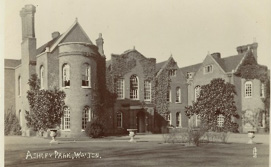Up until the end of the 19th Century and into the early years of the 20th, Walton was surrounded by several country estates including Ashley Park, Mount Felix and Apps Court. Of these, the closest to the town centre was Ashley Park, about 450 acres of land stretching south of the town, centred round an early Jacobean mansion built in the Tudor style.
The estate boundaries extended from Station Avenue to the centre of Walton and bordered the Oatlands Park estate. Part of the estate wall ran along much of the western side of Walton High Street with entrance gates opening into the street at a point opposite the present premises of W.H. Smith and close to where the High Street entrance to ‘The Heart’ now is. The carriageway from these gates, known as the Grand Drive, was lined on both sides with trees, some of which still survive in Ashley Park Avenue.
Ashley appears as a place name in Walton as early as 1294 although no mention is made in the Domesday Book of two hundred years earlier. It became part of Henry VIII’s hunting ground, the Honour of Hampton Court, in 1539 but it was the trustees of Lady Jane Berkeley, wife of the 7th Lord Berkeley, who had the mansion built between 1602 and 1607. Constructed mainly from locally-made bricks and timber from Surrey woodlands, it had a succession of other distinguished owners including the 7th Earl of Argyle and the 1st Earl of Anglesey. In about 1720, it was purchased by Richard Boyle, Viscount Shannon, whose military achievements are commemorated in a grand monument by Louis Roubiliac in St. Mary’s Parish Church.
Ashley Park was inherited by Sir Henry Fletcher, MP for the county of Cumberland, in 1786 and he enlarged the estate in 1804 from its original 190 acres. It remained in the family for four generations and there are three Henry Fletchers buried in St Mary’s Church and remembered there in monuments and stained glass windows. The house was bought from the Fletchers in 1862 by the Sassoon family, who maintained close links between the house and the population of Walton, including the opening up of the park for social and sporting events. The house was still in the family when it was finally sold in 1923. It was demolished about two years later.
Although most of the park was developed as a residential estate, part of the gardens and estate buildings including some lodges, still survive. The building of greatest interest is a house, once called Ashley Cottage, at the Walton end of Oatlands Drive, which is believed to have been a dower house when the estate was owned by the Fletchers. Another building with close connections is the building behind the frontage of what is now Superdrug on the corner of High Street and Churchfield Road. This was a village hall gifted to the people of Walton in 1879 on the occasion of Joseph and Louise Sassoon’s marriage. It was in this building that, before the age of cinema, Walton film pioneer, Cecil Hepworth, showed some of the earliest films ever made in this country.
John C Pulford.
References.
History of Ashley Park. Michael Blackman, Walton and Weybridge Local History Society, 1976.
A Short History of Walton-on-Thames. Michael Blackman, Walton and Weybridge Local History Society, 1989.
The Sassoons of Ashley Park, Michael Dane, 1999.
Came the Dawn, Cecil Hepworth, Phoenix House, 1951.
Photos from a private collection.

